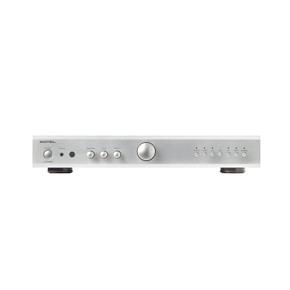New, Upraded Version of Integrated Amp with DAC and MM Phono Stage
The A14 has been the flagship integrated amplifier model in Rotel’s 14 Series. Building upon the successful and award winning A14, the new A14MKII is packed with upgrades, including a new Texas Instruments DAC supporting 32-bit, 384 kHz audio complemented by 25 component changes in the DAC output filters. Power supply component changes were also implemented leveraging design strategies from Rotel’s Tribute models. Additional circuit changes in the signal path circuits provide a richer and fuller audio performance with even more lifelike reproduction of the audio. The MkII is Certified Roon Tested, too.
The A14MKII supports all popular source inputs, including aptX™ and AAC Bluetooth for wireless streaming, PC-USB up to 32-bit 384 kHz, MQA decoding and rendering, analog, digital and a Moving Magnet phono stage.
Built in MM Phono Stage and Texas Instruments DAC
The A14MKII is ready, able, and willing to deliver exceptional musical performance from digital and analog sources. The built-in high quality MM moving magnet phono stage lets you directly plug in your turntable and start listening to your favorite LPs. No outboard equipment is needed, and the built-in circuitry rivals the performance of many stand along phono stages.
On the digital side, the built-in DAC does a splendid job with music files. It uses a premium 32-bit/384 kHz digital-to-analog converter chip set from Texas Instruments, with 25 component changes in the DAC output filters. Coaxial and optical digital inputs plus USB allow you connect a wide range of digital music sources. Bluetooth with aptX streaming allows you to send music from your smartphone, tablet, and other devices to the A14MKII.
High Power and Wide Feature Set
The flagship A14MKII has the highest power and widest set of features in its range. The A14MKII is rated at 80 watts per channel RMS into 8 ohms, both channels driven. Yet ratings alone do not reflect real world usage. The A14MKII features a rugged power supply comprising a Rotel-manufactured toroidal transformer plus slit-foil capacitors to effortlessly handle difficult speaker loads and dynamic signal peaks.
This is an impressively flexible audio component, designed to accommodate both classic analog and the latest digital source components supported by the onboard Texas Instruments DAC. But its greatest strength lies in its ability to render a musical performance exactly as the artist intended.
Another great feature is the ability to download a free full-featured control app from Rotel for Android and iOS. This gives you convenience and capability of controlling the A14MKII through your smartphone or tablet.
Highly Regulated Power Supply
This amplifier is a full featured, high performance component. All aspects of the design have been optimized to retain the full dynamic range and subtle nuances of your music. The unit has a highly regulated power supply incorporating a Rotel custom-designed toroidal power transformer. Power supply component changes for the A14MKII were implemented using design strategies from Rotel’s Tribute models. This low impedance power supply has ample power reserves, which enables the amplifier to easily reproduce the most demanding audio signals. This type of design is more expensive to manufacture, but it is better for the music.
The printed circuit boards (PCB) are designed with Symmetrical Circuit Traces. This ensures that the precise timing of the music is maintained and faithfully recreated. The circuitry uses metal film resistors and polystyrene or polypropylene capacitors in important signal paths. All aspects of this design have been examined to ensure the most faithful music reproduction.
Along with providing exceptional listening enjoyment, the A14MKII was purposefully designed with simplicity in mind. The main functions of the A14MKII are easy to install and use. If you have experience with other stereo systems, you shouldn’t find anything perplexing. Simply plug in the associated components and enjoy. It's all about enjoying your music and forgetting the technology behind it.



























